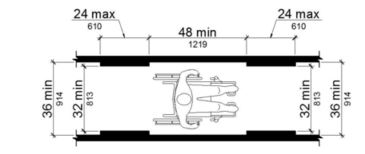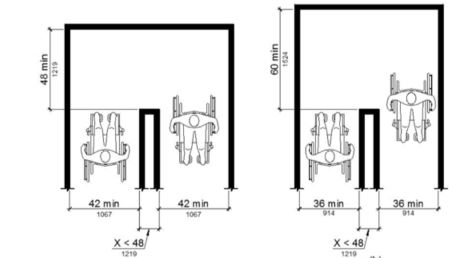2019 California Standards for Accessible Design Guide (effective January 1, 2020 with July 1, 2021 amendments)
11B-403 Walking surfaces
11B-403.1 General.
Walking surfaces that are a part of an accessible route shall comply with Section 11B-403.
11B-403.2 Floor or ground surface.
Floor or ground surfaces shall comply with Section 11B-302.
11B-403.3 Slope.
The running slope of walking surfaces shall not be steeper than 1:20. The cross slope of walking surfaces shall not be steeper than 1:48.
Exception: The running slope of sidewalks shall not exceed the general grade established for the adjacent street or highway.

When the running slope of a walking surface exceeds 5%, it must comply with the accessibility requirements for ramps.
A sloping sidewalk with a running slope in excess of 5% is excluded from ramp requirements for landings and handrails but it must comply with cross-slope and width requirements. ◼
ETA Editor's Note
The 2019 CBC Exception at 11B-403.3 is not present in the 2010 ADA Standards. Therefore, technically, the 2010 ADA Standards are more stringent with regard to the slope of sidewalks at streets or highways. CBC does not define street or highway but does define sidewalk as " ... contiguous to a street used by the public." It is inferable, whether intended or not, that sidewalks serving as accessible routes alongside private roadways are not excepted from the slope limitation.
In 2011, the U.S. Access Board published in the Federal Register its Proposed Guidelines for Pedestrian Facilities in the Public Right-Of-Way, along with a Notice of Proposed Rulemaking. The public comment period was concluded in 2012, and the guidelines are in the Final Rulemaking stage now. Until these guidelines become law, the Access Board is offering guidance on its website, where one can also request technical assistance and/or sign up for updates as to the rulemaking status: http://www.access-board.gov/guidelines-and-standards/streets-sidewalks/public-rights-of-way/.
In 2013, in response to feedback, the U.S. Access Board issued a proposed Supplemental Rule to address accessibility for Shared Use Paths (used by pedestrians, bicyclists, and others for transportation or recreation), distinguished from sidewalks, as well as from trails. More information about this rulemaking process is available on the Access Board’s website: https://www.access-board.gov/guidelines-and-standards/streets-sidewalks/shared-use-paths.
11B-403.4 Changes in level.
Changes in level shall comply with Section 11B-303.
11B-403.5 Clearances.
Walking surfaces shall provide clearances complying with Section 11B-403.5.
Exception: Within employee work areas, clearances on common use circulation paths shall be permitted to be decreased by work area equipment provided that the decrease is essential to the function of the work being performed.
11B-403.5.1 Clear width.
Except as provided in Sections 11B-403.5.2 and 11B-403.5.3, the clear width of walking surfaces shall be 36 inches (914 mm) minimum.
Exceptions:
- The clear width shall be permitted to be reduced to 32 inches (813 mm) minimum for a length of 24 inches (610 mm) maximum provided that reduced width segments are separated by segments that are 48 inches (1219 mm) long minimum and 36 inches (914 mm) wide minimum.
- The clear width for walking surfaces in corridors serving an occupant load of 10 or more shall be 44 inches (1118 mm) minimum.
- The clear width for sidewalks and walks shall be 48 inches (1219 mm) minimum. When, because of right-of-way restrictions, natural barriers or other existing conditions, the enforcing agency determines that compliance with the 48-inch (1219 mm) clear sidewalk width would create an unreasonable hardship, the clear width may be reduced to 36 inches (914 mm).
- The clear width for aisles shall be 36 inches (914 mm) minimum if serving elements on only one side, and 44 inches (1118 mm) minimum if serving elements on both sides.
- The clear width for accessible routes to accessible toilet compartments shall be 44 inches (1118 mm) except for door-opening widths and door swings.
ETA Editor's Note
CBC Exceptions 2, 3 and 4 at 11B-403.5.1 are not present in the 2010 ADA Standards. Therefore, CBC requirements related to the clear width of accessible routes are more stringent.

FIGURE 11B-403.5.1 CLEAR WIDTH OF AN ACCESSIBLE ROUTE
11B-403.5.2 Clear width at turn.
Where the accessible route makes a 180 degree turn around an element which is less than 48 inches (1219 mm) wide, clear width shall be 42 inches (1067 mm) minimum approaching the turn, 48 inches (1219 mm) minimum at the turn and 42 inches (1067 mm) minimum leaving the turn.
Exception: Where the clear width at the turn is 60 inches (1524 mm) minimum compliance with Section 11B-403.5.2 shall not be required.

FIGURE 11B-403.5.2 CLEAR WIDTH AT TURN
11B-403.5.3 Passing spaces.
An accessible route with a clear width less than 60 inches (1524 mm) shall provide passing spaces at intervals of 200 feet (60,960 mm) maximum. Passing spaces shall be either: a space 60 inches (1524 mm) minimum by 60 inches (1524 mm) minimum; or, an intersection of two walking surfaces providing a T-shaped space complying with Section 11B-304.3.2 where the base and arms of the T-shaped space extend 48 inches (1219 mm) minimum beyond the intersection.
11B-403.6 Handrails.
Where handrails are provided along walking surfaces with running slopes not steeper than 1:20 they shall comply with Section 11B-505.

11B-403.7 Continuous gradient.
All walks with continuous gradients shall have resting areas, 60 inches (1524 mm) in length, at intervals of 400 feet (121,920 mm) maximum. The resting area shall be at least as wide as the walk. The slope of the resting area in all directions shall be 1:48 maximum.
ETA Editor's Note
CBC requirement 11B-403.7 is not present in the 2010 ADA Standards. Therefore, CBC requirements related to continuous gradients are more stringent.

User Comments/Questions
Add Comment/Question